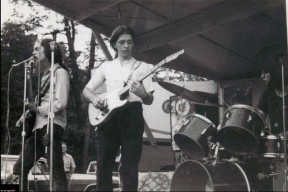…no more bullshit. That’s the simple truth.
And whether it’s in architecture, politics or art, it’s about time that everyone start calling a spade, a spade.
There’s a great blog article I was reading that brought this concept and it’s encumbant realities to the fore – http://observatory.designobserver.com/feature/on-design-bullshit/3347/. It’s by Michael Bierut and discusses the concept of (Design) Bullshit. In it, he discusses a situation that occurred between the architect RIchard Meier and the garden designer, Robert Irwin, whom Meier felt was not appropriate for this task.
The artist’s (Irwin’s) bias for whimsical organic forms, his disregard for the architecture’s rigorous orthonography, and perhaps even his Detroit Tigers baseball hat all rub Richard Meier the wrong way, and he and his team of architects begin a reasoned, strongly-felt critique of the proposed plan. Irwin, sensing (correctly, as it turns out) that he has the client in his pocket, listens patiently and then says, “You want my response?”
His [Irwin’s] response is the worst accusation you can lodge against a designer: “Bullshit.”
The author, referring to Harry G. Frankfurt’s On Bullshit, goes on to say, “The design process always combines the pursuit of functional goals with countless intuitive, even irrational decisions.” And then, “So into this vacuum rushes the bullshit: theories about the symbolic qualities of colors or typefaces; unprovable claims about the historical inevitability of certain shapes, fanciful forced marriages of arbitrary design elements to hard-headed business goals.
Frankfurt, in his book, defines the difference between bullshit and lies as this. “…bullshit is “not designed primarily to give its audience a false belief about whatever state of affairs may be the topic, but that its primary intention is rather to give its audience a false impression concerning what is going on in the mind of the speaker.”
I find this to be so spot on a description of the state of art in the high art world (and politics, and business and so many other areas today) as to be incredible; that anyone could have stated it with such razor-like clarity truly amazes me. Is this not the feeling that so many of us have each time we are asked to ‘believe’ or ‘accept’ another line from some institution of high pursuit?
To ground this statement in something very real, isn’t this just want many of us want to say when we walk through so many museums today? Or listen to so many politicians espousing their bullshit views?The level of bullshit that is pushed out from the art institutions – schools, museums, curators, etc. – is beyond credulity.
And yet, each time we find ourselves feeling like they can’t take it any further, some set of artists, dealers, collectors and museums finds a way to pile up another ‘ism’ that is immediately imbued with the imprimartur of ‘excellence’ and relevance.The bullshit meter goes way up immediately because we all know, as is so evident in the world of high finances today, that all of this is simply a ruse to create another commodity that can be exchanged and revalued like stock.
Ironically, even the bullshitters know the genuine article, sometimes, when they see it. As an example, look at the rush that to buy contemporary Chinese art when China entered the market world. And even with that, it is already compromised by the very bullshit it tried to get away from.
It is not at all exceptional that the art world and so many of its artists should be contributors to this charade. The one thing any aspiring artist knows is that fame or infamy (even better) are the solid gold currency of today’s market place. Of course it has to be combined with clever art world afficiandos and, hopefully, with the backing of some ‘investor’ who sees the potential for this artists value to soar.
All told, there is no doubt that bullshit is a part of creating art of any kind. You have to, at some point or other, believe in things you produce even if you aren’t sure they are good. So, to sure things up, each of us creates a line of bs that we hang onto when we aren’t really convinced of what we have done.The problem comes in when we believe our own bullshit.
And THAT is where we’re at now as a culture and an economy. We have for some time believed all the crap we have written and stated about ourselves, so much so that many of us wouldn’t know and a few only barely recognize a truly genunine person or object when we saw it.It used to be, not all that long ago, that those artists who weren’t able to communicate genuinely through their work but whose work was well executed, would be understood as such and seen by themselves and others as talented and valuable but not genius.
True genius, in the sense of something truly genuine (From Latin genius, meaning “the guardian spirit of a person, spirit, inclination, wit, genius, literally ‘inborn nature’”) , must communicate something true about the artist and/or the subject, even if the artist doesn’t realize it. Sadly, this has been completely lost in the commodification of all things and people. We have bought into the bullshit so much that we no longer see it for what it is. If you have any doubt, turn on almost any major TV show, or pick up so many publications, regardless of subject matter.
As a young man, I thought myself to be the most vulnerable of people, waiting at every moment to be attacked. Yet, through that experience, I saw that my problem was I had no idea how to be anything other than who I was – open and sincere (and waiting to be victimized.) I even understood, for a while, that maybe that was the role of the artist, to show how it’s possible, or even beneficial, to leave yourself open in spite of the abuse. Time, economy and the cultural hegemony of the warthogs have changed all that.
Now, when I look back on that time, I see that THIS is the thing I miss the most in almost every aspect of american life today – open, honest sincerity that expresses the genuine good nature that underlies all things. People disagreed, sometimes violently, but there was to some greater extent, a belief in basic human goodness.
As we head further and deeper into the abyss of racist, sexist, greed-driven, faith-based self-absorption that defines today’s culture, I try each day to find one thing that reminds me of the people I knew when I was young and the incredible genuine innocence they imbued my life with. I miss them, and that feeling, terribly.






